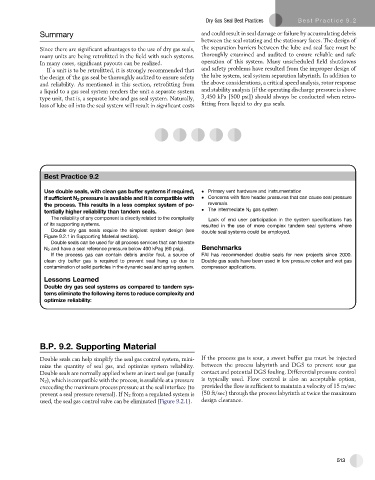Page 542 - Subyek Teknik Mesin - Forsthoffers Best Practice Handbook for Rotating Machinery by William E Forsthoffer
P. 542
Dry Gas Seal Best Practices Be st Practice 9.2
Summary and could result in seal damage or failure by accumulating debris
between the seal rotating and the stationary faces. The design of
Since there are significant advantages to the use of dry gas seals, the separation barriers between the lube and seal face must be
many units are being retrofitted in the field with such systems. thoroughly examined and audited to ensure reliable and safe
In many cases, significant payouts can be realized. operation of this system. Many unscheduled field shutdowns
If a unit is to be retrofitted, it is strongly recommended that and safety problems have resulted from the improper design of
the design of the gas seal be thoroughly audited to ensure safety the lube system, seal system separation labyrinth. In addition to
and reliability. As mentioned in this section, retrofitting from the above considerations, a critical speed analysis, rotor response
a liquid to a gas seal system renders the unit a separate system and stability analysis (if the operating discharge pressure is above
type unit, that is, a separate lube and gas seal system. Naturally, 3,450 kPa [500 psi]) should always be conducted when retro-
loss of lube oil into the seal system will result in significant costs fitting from liquid to dry gas seals.
Best
Best Practice 9.2Practice 9.2
Use double seals, with clean gas buffer systems if required, Primary vent hardware and instrumentation
if sufficient N 2 pressure is available and it is compatible with Concerns with flare header pressures that can cause seal pressure
the process. This results in a less complex system of po- reversals
tentially higher reliability than tandem seals. The intermediate N 2 gas system
The reliability of any component is directly related to the complexity Lack of end user participation in the system specifications has
of its supporting systems. resulted in the use of more complex tandem seal systems where
Double dry gas seals require the simplest system design (see double seal systems could be employed.
Figure 9.2.1 in Supporting Material section).
Double seals can be used for all process services that can tolerate
N 2 and have a seal reference pressure below 400 kPag (60 psig). Benchmarks
If the process gas can contain debris and/or foul, a source of FAI has recommended double seals for new projects since 2000.
clean dry buffer gas is required to prevent seal hang up due to Double gas seals have been used in low pressure coker and wet gas
contamination of solid particles in the dynamic seal and spring system. compressor applications.
Lessons Learned
Double dry gas seal systems as compared to tandem sys-
tems eliminate the following items to reduce complexity and
optimize reliability:
B.P. 9.2. Supporting Material
Double seals can help simplify the seal gas control system, mini- If the process gas is sour, a sweet buffer gas must be injected
mize the quantity of seal gas, and optimize system reliability. between the process labyrinth and DGS to prevent sour gas
Double seals are normally applied where an inert seal gas (usually contact and potential DGS fouling. Differential pressure control
N 2 ), which is compatible with theprocess, is available ata pressure is typically used. Flow control is also an acceptable option,
exceeding the maximum process pressure at the seal interface (to provided the flow is sufficient to maintain a velocity of 15 m/sec
prevent a seal pressure reversal). If N 2 from a regulated system is (50 ft/sec) through the process labyrinth at twice the maximum
used, the seal gas control valve can be eliminated (Figure 9.2.1). design clearance.
513

